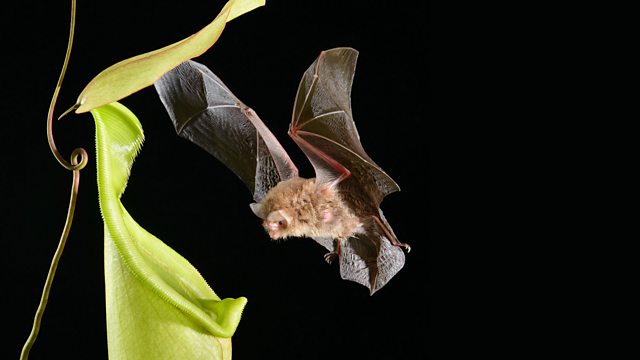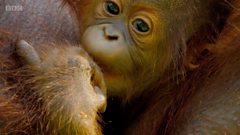Borneo
A journey from Borneo's rich coral reefs, through lush jungles to its mountainous heart, revealing why this island is home to a greater variety of life than almost any other.
In the heart of south east Asia lies the tropical island of Borneo. Twice the size of the British Isles, it is the third largest island on earth and home to possibly the greatest diversity of life of any island - from flying lizards sun bears to orangutans. Its huge variety of habitats, from bustling coral reefs and ancient jungles to towering mountains, has given rise to over 60,000 species of plants and animals - many found nowhere else on earth.
Borneo’s shoreline is fringed by a tangle of mangroves and flooded forests, home to an extraordinary creature – the proboscis monkey. Their unique pot bellies allow them to survive on the nutrient-poor leaves, but even so, they must continually search for the freshest shoots. This means the whole family must cross one of many rivers that cut through the forest – patrolled by giant crocodiles. It is a drama rarely seen.
The island of Borneo is surrounded by some of the richest coral reefs in the world – a single reef can support more species of coral than the entire Caribbean Sea! This remarkable abundance attracted seafaring nomads, the Bajau Laut, ‘people of the sea’. Over generations their bodies have transformed, making them the ultimate human divers – but they are having to adapt to the modern world – using ingenuity to turn plastic waste that washes up on the beach to their advantage.
Heading inland are ancient forests, home to giants – the dipterocarps. Towering up to 100 metres high, they are the tallest rainforest trees in the world. A single tree can hold a thousand different species, and this intense competition has driven many animals to evolve in wondrous ways – on this island reptiles can fly.
At night, this competition in the jungle intensifies as many of Borneo’s 180 species of frog call for a mate. The bigger the frog, the louder the call: a problem for one of the smallest frogs on the island. In this never-before-filmed sequence, a male tree-hole frog, barely larger than a thumbnail, has come up with an ingenious solution to being heard above the noise.
Compared to the abundance of life in the treetops, the forest floor is an impoverished world. With little to eat, many of Borneo’s terrestrial mammals are smaller than on the mainland – including the exceedingly rare Bornean sun bear. At just over 1m long, it is the smallest bear in the world. To survive, they have developed a surprising skill - they are expert climbers, able to climb higher than any other bear, to feed on honey and fruits high up in the canopy.
For those confined to the forest floor, more ingenious methods are required. The Penan are indigenous hunters that have lived in Borneo’s forests for over 4,000 years. They use a remarkable sign language, known as Oroo’, to communicate through the jungle. A long stick is adorned with intricately folded vegetation and shaped bark, to tell a complex story.
In the heart of the island, looming above the rainforest, lies another of Borneo’s diverse habitats – mountains. Their range runs over 500 miles through the centre of the island. At over 4,000 metres, Mount Kinabalu is one of the highest peaks in south east Asia. It rains here almost every day, the water washing away any goodness in the soil. To get the nutrients they need to survive, one group of plants have gone to extreme lengths, becoming carnivores. The modified leaves of pitcher plants form pitfall traps. Insects are lured to the trap’s edge with sweet nectar, before slipping into a lethal pool of digestive enzymes. Borneo holds the greatest collection of pitcher plants in the world, including one that is after something much bigger than insects. Nepenthes hemsleyana is a pitcher plant that has evolved to attract woolly bats. Its traps are perfectly adapted to provide a sheltered roost for the bat. In return the plant gains nutrition from the bats droppings, a remarkable relationship, only recently discovered.
Borneo’s intense rain has carved out vast cave systems through the island. Deer cave is so large you could fly a jumbo jet through it. They are home to millions of bats whose guano forms the basis of an entire ecosystem – sustaining some of the largest concentrations of cockroaches in the world, as well a wealth of other cave critters.
Thanks to the bats, even in this most extreme habitat, Borneo harbours an extraordinary array of life.
For 10,000 years, Borneo’s staggering diversity has been protected by its isolation, but with the arrival of industrial logging, all that has changed. Only half of its ancient forests are left, and much of its unique wildlife is under threat, including the iconic orangutan. Scientists are only just discovering the true scale of their intelligence – recently capturing footage of a mother orangutan using forest leaves to create an anti-inflammatory treatment for her aching joints. But with their forest home being destroyed, how much longer can these remarkable animals survive?
On TV
More episodes
Previous
Next
Clips
-
![]()
A leap of faith
Duration: 02:59
-
![]()
How clever is Borneo's most iconic resident?
Duration: 01:32
-
![]()
The sun bear of Borneo
Duration: 02:14
Music Played
-
![]()
Hans Zimmer, Jacob Shea & David Fleming
Surfing Dolphins
-
![]()
Hans Zimmer, Jacob Shea & David Fleming
Walrus: The Right Piece of Ice
Credits
| Role | Contributor |
|---|---|
| Narrator | David Harewood |
| Series Producer | Kathryn Jeffs |
| Executive Producer | Mark Brownlow |
| Production Manager | Dulcie Arnold |
| Producer | Will Ridgeon |
| Composer | Michael Kruk |
Broadcasts
- Thu 2 Jan 2020 21:00
- Sat 11 Jan 2020 20:00Â鶹ԼÅÄ Two except Wales & Wales HD
- Thu 13 Feb 2020 01:25
- Sat 3 Oct 2020 20:00
- Tue 29 Dec 2020 17:00Â鶹ԼÅÄ Two except Wales & Wales HD
- Sun 9 Jan 2022 18:00Â鶹ԼÅÄ Two except Wales & Wales HD
- Mon 20 Jun 2022 20:00
- Tue 21 Jun 2022 01:30
- Wed 27 Dec 2023 19:00
- Fri 29 Dec 2023 02:30
- Wed 9 Oct 2024 16:15
- Boxing Day 2024 00:20
- Boxing Day 2024 02:50





